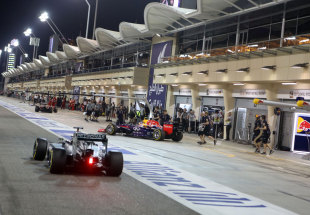

The Ouroboros is an ancient symbol of eternity. Believed to date from Ancient Egypt, it is depicted by a snake eating its own tail, creating an endless circle. Sitting in the Friday press conference in the Sepang paddock, listening to one of Formula One's most high-profile figures criticise every aspect of the new formula, the Ouroboros was all I could think of.
But eternity could not have been further from my mind - if F1 continues to eat its own tail, at the current rate of progress we will have eaten all the way round the circle before the season comes to an end, leaving little more than a head and an awful lot of waste product.
I take no issue with the right of anyone in this sport to voice their opinion. As a writer whose income derives largely from selling my opinions, it would be a shade hypocritical of me. But I find it hard to believe that anyone can look at the new era of Formula One and see only negatives. Scratch that - I may be a Pollyanna, but I find it hard to look at anything and see only negatives. Every cloud has a silver lining, and all that.
The 2014 cars are quieter, which some feels harms the spectacle, but they're also more challenging to drive, which improves the spectacle. The cars are heavier, but that only makes the improved fuel economy all the more impressive. The loss of rear downforce makes them slower in high-speed corners, but they are faster along the straights.
For every negative element there is a positive.
But the most positive element of all can be seen on track at each and every session - it's the human ingenuity (and a hell of a lot of hard work) that has made this new generation of Formula One possible. I am dumbfounded by the notion that anyone - fan or team professional - can fail to be impressed by the exponential progress we are seeing this season.
Taking Red Bull as an example, who would have thought in Jerez that either of the team's drivers would be in with a shot of standing on the podium at Albert Park? And while that result is currently a matter of dispute, Sebastian Vettel's Sepang podium finish is not.
To achieve such an impressive turnaround in such a short space of time is no mean feat. It takes a lot of late nights, hard work, and innovative thinking (not to mention the judicious application of rather a lot of energy drinks, be they caffeine or taurine), and it is something that should be celebrated.
Red Bull are not the only team to have improved by leaps and bounds over the course of two-and-a-bit race weekends and 12 days of testing. At the three engine manufacturers' bases, years of work have gone in to creating power units that are capable of coming close to the familiar V8s in terms of oomph, all the while driving heavier cars while using considerably less fuel.
Sure, they're not yet up to par. But cast your mind back to the last engine change - it took more than three races for that technology to bed in.
Unless Formula One's household names and key stakeholders can find something positive to say about this new era, perhaps they should do as their mothers would surely recommend and refrain from saying anything at all.
To do anything less not only undermines the hard work from teams and suppliers the length of the paddock - all of whom should be proud of what they have accomplished - but it also influences (negatively) fans, sponsors, and race organisers, which in turn affects the sport's financial health and future viability.
Make no mistake - unless we can improve the message, F1 will eat itself.
